Ubeer Naqushbandi
SRINAGAR

In a bid to boost tourism, JK tourism department is adding many attractions inside Hari Parbat Fort, including museum, sound and light show, Director Tourism Mahmood Shah told Kashmir Life.
Besides overview of Shar-e-Khaas, the director said, the department wants tourists to have a peep into its glorious past. “This is the idea we are working on,” he said.
The number of tourists who visited the fort this year from January stands 350, including 110 foreigners.
“The tourists are already thronging the site but recent publicity about it in media was to create awareness particularly among tourists that the historical site is open for them as well,” Shah said.
The Fort which was closed in 1990s by forces after the eruption of armed rebellion in Kashmir has always remained out of bounds for the people, especially for the youth of Shar-e- Khaas.
“I always wondered what this huge mansion standing on Khoh-e-Maran is all about,” said an old city young girl, Zarka.
It was Akbar who started building bunkers during 1596 over the Khoh-e-Maran and which was completed in Jehangir’s tenure in 1618. But, the fort in real sense was built by Amir Khan Jawaane Sher, governor during Afghan rule, says the noted poet-historian, Zareef Ahmed Zareef.

Pic: Bilal Bahadur
The fort has a unique blend of ‘Kashmiriyat’ with mosque already been there ever since. During Sikh and Dogra rule, Gurudwara and Mandir were built subsequently, says Zareef.
Recalling the times before the fort was fortified by forces, Zareef says that every year on the onset on ‘Navratra’, Kashmiri Pandits used to throng to Sharika Devi Mandir (temple) Chark Ishwara Asthapan along with Muslim brethren. “The atmosphere of the nearby Badam veeri added to the spiritual aroma and could become elixir for a person lying on the death bed.”
The fort also had huge cache of ammunition, which was loaded on cannons.
“Every day one cannon was launched in morning to mark beginning of the day and second was launched at noon to inform population about the mid day. This tradition was followed during Dogra rule and continued until 1953 in Sheikh Abdullah’s tenure,” Zareef says.
But, whatever historical things were the fort consisted, those were sold by unscrupulous elements to rag dealers, he says.
The desecration of Masjid inside fort “by forces” once became major controversy, which after raising hue and cry by Valley Citizens Council headed by Zareef was stopped.
The fort which is spanned over 50kanals of land has three talaavs (ponds) and lawns.















